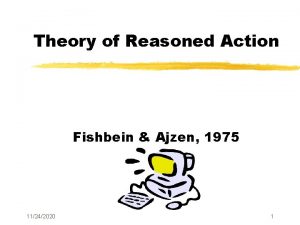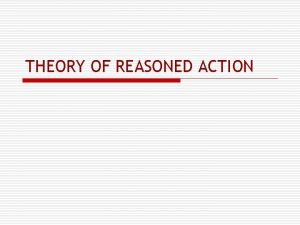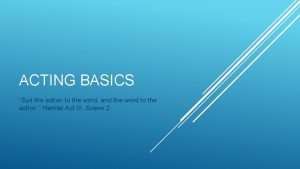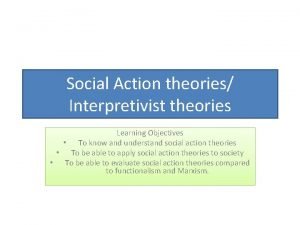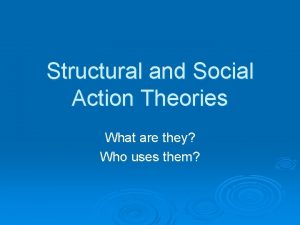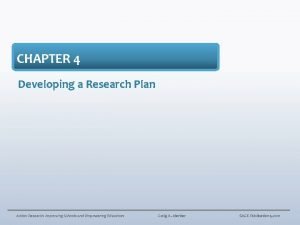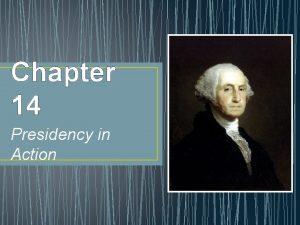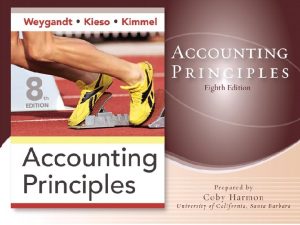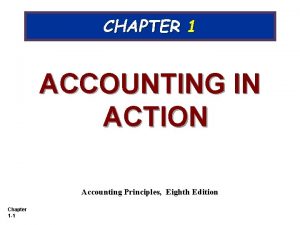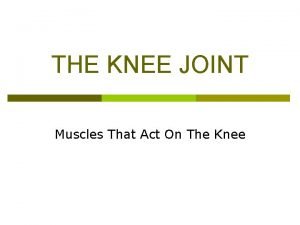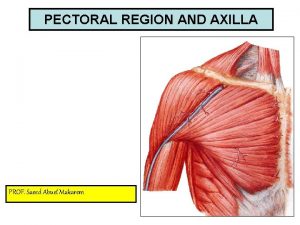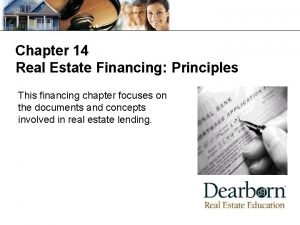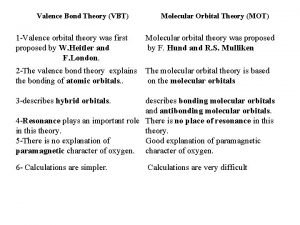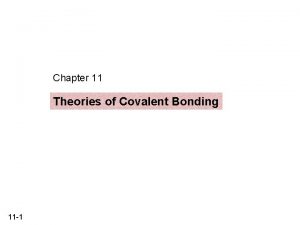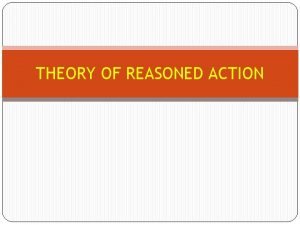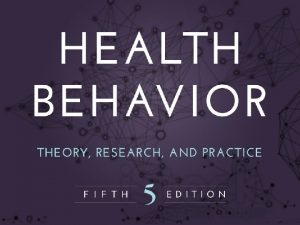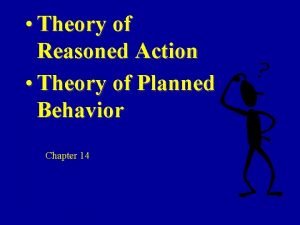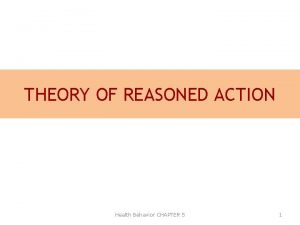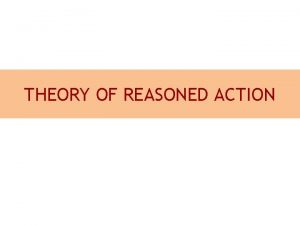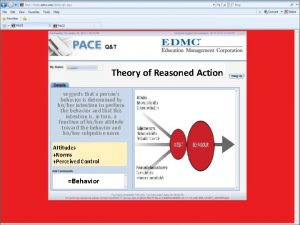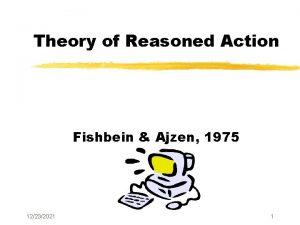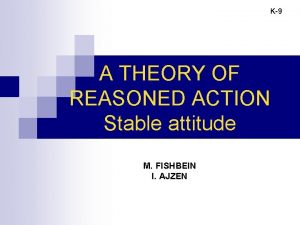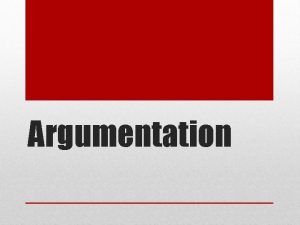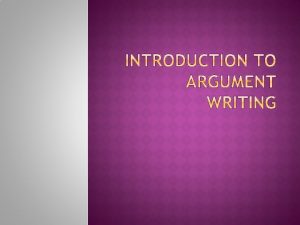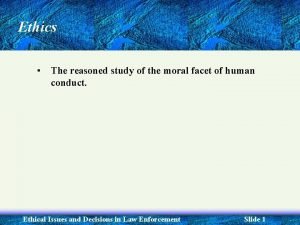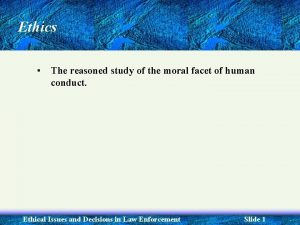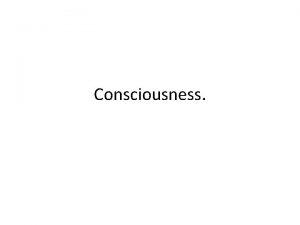CHAPTER 5 Theory of Reasoned Action and Theory





































- Slides: 37

CHAPTER 5 Theory of Reasoned Action and Theory of Planned Behavior

Historical Evolution • 1960 s: Theory of reasoned action (TRA) was introduced by Martin Fishbein to explain the relationship between attitudes and behavior • 1970 s: Fishbein teamed up with Icek Ajzen of the University of Massachusetts, Amherst, to write the book Belief, Attitude, Intention and Behavior: An Introduction to Theory and Research • 1980 s: TRA was extensively studied with health behaviors and interventions • 1990 s: An extension of TRA, theory of planned behavior (TPB), is introduced • 2009: Death of Fishbein

Assumptions of TRA • Assumes that people are rational and that reasoning is the primary determinant of behavioral intent • Distinguishes between an attitude toward an object and an attitude toward behavior, for example, the object of breast cancer versus the behavior of seeking mammography • Does not take into account the elements of fear or irrational thought

Principles of TRA • Includes measures of attitudes and social normative perceptions that determine behavior • Addresses relationships among beliefs (behavioral and normative), attitudes, intentions, and behavior • Attitudes toward a particular behavior and beliefs about subjective norms can be highly predictive of behavior (30%– 40%)

TRA and TPB Figure 5 -1: The upper portion including proximal constructs of attitude toward behavior and subjective norm constitute theory of reasoned action; all three proximal constructs together constitute theory of planned behavior.

TRA Construct 1: Behavior • Usually this is a single action performed by an individual that is observable – Examples are condom use, eating five servings of vegetables and fruits, and so on

TRA Construct 1 (cont’d) • Sometimes behavioral categories involve a set of actions that are not easily observable rather than a single observable action – Examples are being physically active every day, eating healthy, and so on • Behavior should be defined in terms of its target, action, context, and time (TACT)

TRA Construct 2: Behavioral Intention • Perceived likelihood of performing the behavior • Intention is a proximal measure of behavior • Measured on a bipolar scale of extremely improbable (– 3) to extremely probable (+3) • Among the most important determinants of behavior • For example, a person who intends on exercising in the next week is likely to exercise

TRA Construct 3: Attitude Toward Behavior • Two components – Behavioral beliefs: Beliefs that behavioral performance is associated with certain attributes or outcomes – Evaluation of behavioral outcomes (outcome evaluation): Values associated with a behavioral outcome or attribute

TRA Construct 4: Behavioral Belief • Belief that behavioral performance is associated with certain attributes or outcomes • Measured on a unipolar scale of extremely unlikely (1) to extremely likely (7) • For example, a person who believes that exercise is likely to tone muscles is likely to exercise

Computing Behavioral Beliefs Exercising daily will result in toning of muscles for me (Behavioral belief… 1) Extremely Unlikely 1 2 3 4 5 6 7 Extremely Likely (Collect data for all possible beliefs on the subscale)

TRA Construct 5: Outcome Evaluations • Value attached to a behavioral outcome or attribute • Measured on a bipolar scale of bad (– 3) to good (+3) • Interacts with behavioral belief • For example, a person who believes that exercise is likely to tone muscles but does not care about how toned his or her muscles are is unlikely to exercise

Computing Outcome Evaluations Toning muscles is (Attitudinal Evaluation. . . 1) Bad – 3 – 2 – 1 0 1 2 3 Good (Collect data for all possible evaluations on the subscale)

Computing Attitude Score Toward a Behavior • Multiply each behavioral belief by the evaluation ratings for each outcome evaluation and then sum all of the products; the result is the score for attitude toward behavior

TRA Construct 6: Subjective Norm • Subjective norm refers to one’s belief that most of the significant others in one’s life think one should or should not perform the behavior – For example, a person may think that if he or she exercises, his or her spouse would be proud of that person

TRA Construct 6 (cont’d) • Two components – Normative beliefs: Beliefs about whether each referent approves or disapproves of the behavior – Motivation to comply: Motivation to adhere to what each referent thinks the person should do

TRA Construct 7: Normative Belief • Belief about whether each referent approves or disapproves of the behavior • Measured on a bipolar scale of disagree (– 3) to agree (+3) • For example, if a person believes that his or her family members approve of his or her waking up early in the morning and jogging, he or she is likely to jog

Computing Normative Beliefs List salient referents from elicitation interviews for the behavior. My family approves of my early-morning jogging: Disagree – 3 2 – 1 0 1 2 3 Agree (Collect data for all possible beliefs on the subscale)

TRA Construct 8: Motivation to Comply • Motivation to adhere to what each referent thinks the person should do • Measured on a unipolar scale of unlikely (1) to likely (7) • For example, if a person believes that his or her family members want him or her to jog early in the morning, he or she is likely to jog

Computing Motivation to Comply How likely is it that my family wants me to jog early in the morning? Unlikely 1 2 3 4 5 6 7 Likely (Collect data for all possible motivations on the subscale)

Computing Subjective Norm Score • Multiply normative belief by motivation to comply for each referent and then sum across all referents; the result is the score for the construct of subjective norm

Added Construct TPB 9: Perceived Behavioral Control • How much a person feels he or she is in command of enacting the given behavior • Two components – Control beliefs: Perceived likelihood of occurrence of facilitating or constraining conditions – Perceived power: Perceived effect of conditions in making behavioral performance difficult or easy

TPB Construct 10: Control Belief • Beliefs about internal and external factors that may inhibit or facilitate the performance of the behavior • Measured on a unipolar scale of unlikely (1) to likely (7) • For example, the likelihood of jogging when it is raining outside

Computing Control Beliefs How likely is it that I will jog when it is raining outside? Very Unlikely 1 2 3 4 5 6 7 Likely (Collect data for all possible beliefs on the subscale)

TPB Construct 11: Perceived Power • Perception about how easy or difficult it is for performing the behavior in each condition identified in control beliefs • Measured on a scale of difficult (– 3) to easy (+3) • For example, when it is raining, it is very difficult to jog

Computing Perceived Power How difficult is it to jog when it is raining outside? Very Difficult – 3 – 2 – 1 0 1 2 3 Very Easy (Collect data for all possible conditions on the subscale)

Computing Perceived Behavioral Control Score • Multiply control beliefs by perceived power for each referent, and then sum across all control factors; the result is the score for the construct of perceived behavioral control

Application of TPB Figure 5 -2: How theory of planned behavior can be used for promoting condom use behavior.

• Precise guidance regarding measurement • Help interventions to focus on the most important factors • Evaluation of TRA and TPB components at baseline and after the intervention help discern changes over time © Gustavo Frazao/Shutterstock Strengths of TRA and TPB

Limitations of TRA and TPB • Are not behavior change theories but explain relationships among beliefs, intentions, and behaviors • Do not consider personality-related factors, cultural factors, and demographic variables that also shape behavior • Provide precise definitions for measurement of constructs (one of the best) but little guidance for modification • Focus only on rational thoughts and do not consider irrational thoughts or fears

Limitations of TRA and TPB (cont’d) © Aquir/Shutterstock • Measurement is time consuming and cumbersome (relies on interviewer administering personal interview) • Intervention messages may change one belief in the desired direction while adversely affecting another belief

Application Exercise • One TPB example is the study by O’Neill and colleagues (2008) that examined behavioral intentions for adherence to mammography. • Besides the constructs of TPB, they included previous barriers, previous mammography maintenance, and age as potential predictors.

Application Exercise (cont’d) • A cross-sectional survey design was used and administered to 2, 062 currently adherent women who were due for their mammograms in 3 to 4 months. • All TPB variables significantly predicted (p<0. 05) behavioral intention except for subjective norms. • Locate the full-text article of this study and in a critique of 250 words comment on how TPB has been used in this study.

Application Exercise (cont’d) • In your critique pay attention to – How the constructs were reified – Were they operationalized adequately? – Was validity and reliability of the instrument established? – Were the statistical analyses appropriate? – Were the conclusions accurate? – Can the results be generalized?

Websites to Explore • Applying TPB for Obesity Prevention – https: //etd. ohiolink. edu/ap/10? 0: : NO: 10: P 10_ACCES SION_NUM: ucin 1282055620 • Constructing Questionnaires on TRA & TPB – http: //openaccess. city. ac. uk/1735/1/TPB%20 Manual %20 FINAL%20 May 2004. pdf • You Tube: TPB – https: //www. youtube. com/watch? v=C 49 o 3 Occ. S 5 c

Websites to Explore (cont’d) • Professor Icek Aizen (Ajzen) – http: //www. people. umass. edu/aizen/ • Resource Center For Adolescent Pregnancy Prevention (RECAPP) – http: //recapp. etr. org/recapp/ • University of Twente: TPB & TRA – http: //www. tcw. utwente. nl/theorieenoverzicht/Theory %20 clusters/Health%20 Communication/theory_plann ed_behavior. doc/

Skill Building Activity © Bleakstar/Shutterstock • Choose a health behavior. • Diagrammatically draw how you would apply TRA to modify that behavior. • Neatly word process your diagram using software of your choice.
 Fishbein ajzen 1975
Fishbein ajzen 1975 Reasoned action theory adalah
Reasoned action theory adalah Theory of reasoned action adalah
Theory of reasoned action adalah Chronological sequential in medias res flashback
Chronological sequential in medias res flashback Exposition of a story
Exposition of a story Plot stages
Plot stages Exposition in a rose for emily
Exposition in a rose for emily Suit the action to the word the word to the action meaning
Suit the action to the word the word to the action meaning Looking glass self theory
Looking glass self theory Action assembly theory example
Action assembly theory example Social structure examples
Social structure examples Community coalition action theory
Community coalition action theory Living educational theory
Living educational theory Chapter 4 action research sample
Chapter 4 action research sample President appointment power
President appointment power Chapter 1 accounting in action
Chapter 1 accounting in action Example of assets liabilities and owner's equity
Example of assets liabilities and owner's equity Chapter 1 accounting in action
Chapter 1 accounting in action Chapter 14 section 1 the growth of presidential power
Chapter 14 section 1 the growth of presidential power Vastus lateralis origin insertion action
Vastus lateralis origin insertion action Clavipectoral fascia
Clavipectoral fascia Theory x and theory y
Theory x and theory y Continental drift vs plate tectonics
Continental drift vs plate tectonics Continental drift theory and plate tectonics theory
Continental drift theory and plate tectonics theory Neo classical organizational theory
Neo classical organizational theory Motivation in group formation
Motivation in group formation Hawthorne motivation theory
Hawthorne motivation theory Theoretical plates
Theoretical plates Lien theory vs title theory
Lien theory vs title theory X and y theory
X and y theory Game theory and graph theory
Game theory and graph theory Difference between mot and vbt with example
Difference between mot and vbt with example Slidetodoc.com
Slidetodoc.com Theory x and theory y
Theory x and theory y Valence bond theory and molecular orbital theory
Valence bond theory and molecular orbital theory Valence bond theory and molecular orbital theory
Valence bond theory and molecular orbital theory Bond order of li2
Bond order of li2 Col douglas mcgregor
Col douglas mcgregor
